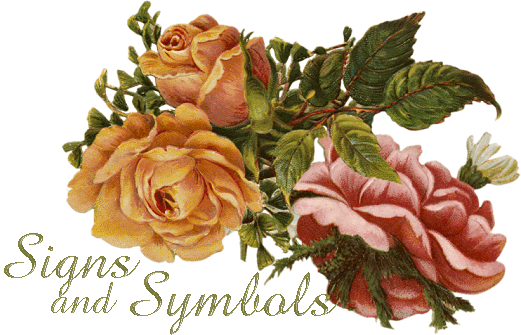 +++Representing God and the Saints+++ ANIMALS, BIRDS, FISH & INSECTS ANT: Christian industry. APE: In art it depicts malice. ASS: Humility. Patience. Animal of the poor. BASILISK: A fabled creature, based on Psalm 91:13: naming four animals for the Antichrist. These were interpreted by St. Augustine as four aspects of the Devil, who was trodden down by the triumphing Christ. Although a well-established symbol, and often represented in the Middle Ages, the basilisk rarely appears in Italian paintings of the Renaissance. BAT: Night. Desolation. BEAR [wild]: Cruelty and evil influence. In the Old Testamtent it represented the kingdom of Persia. BEAR [tame]: Christianity.Typical is the life of St. Euphemia, who, when thrown to wild animals in the arena, was shown honor by a bear who appeared tame, and would not eat her. BEE: Tireless activity. Regal power. Chastity. Also associated with St. Rita of Cascia. BIRDS: Symbol of the "winged soul." Many artists have the Child Jesus holding a bird in His hand. BLACKBIRD: The black feathers and melodious song represented the temptation of sin. Tradition tells us that one day when St. Benedict was praying the Devil appeared to him in the form of a blackbird which tried to divert him from his devotions. St. Benedict was not fooled: he made the Sign of the Cross and the Devil departed in haste. BULL: Depicts strength; sometimes St. Sylvester is shown with a bull at his feet because he brought back a dead bull to life. If the bull is made of brass, this is a symbol of St. Eustace who was Martyred with his family by being encased in a brass bull under which a fire was ignited. BUTTERFLY: Resurrection of Christ. CAMEL: Represents the virtue of temperance because he can go a long time without water. Also a sign of royalty in the Old Testament. Camel's hair is one of the the symbols of St. John the Baptist. CAT: Symbolizes laziness and lust gnerally because of its indolent habits, although the cat is a symbol of good, for instance, when it is shown with the Virgin because tradition has it that a cat gave birth to a litter of kittens in the stable at Bethlehem. Several Annunciation images portray the Virgin Mary with a little cat near her feet. CENTAUR: This mythic animal, part horse, part man is a symbol of St. Anthony Abbot because a mysterious animal appeared to him to point the way to reach St. Paul the Hermit in the desert. COCK: Because the cock crows early in the morning, it symbolizes vigilance, but when depicted in a painting of St. Peter, it signifies his denial of Jesus Christ and subsequent repentance. Thus the cock is now a symbol of the Passion. [John 13:38] CRANE: Vigiliance. Loyalty and good works. Good order in monastic life. It is thought that at night some cranes maintain watch for the others. CROCODILE: Hypocrisy. 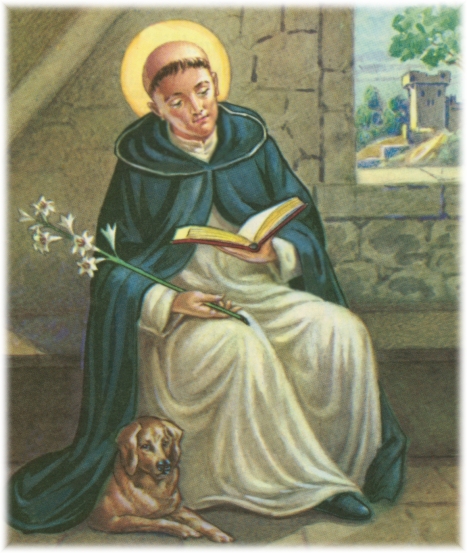 DOG: Fidelity. Loyalty. Watchfulness. Orthodoxy. There are many examples of the faithfulness of dogs, such as the dog of [St.] Tobias and St. Roch, which brought bread to the Saint and remained at hs side. A dog with a flame is a symbol of St. Dominic. Occasionally black and white dogs were used as symbols of the Dominicans [Domini canes, that is dogs of the Lord] because the friars wear black and white robes. DOLPHIN: Resurrection. Faith. Love. Society. Since they swim alongside ships, they symbolize Christ guiding the Church. Often the dolphin is used to depict the whale of Jonah. When the dolphin is pictured with an anchor it represents the Catholic Church. DOVE: Purity. Innocence. Peace. At the time of the flood, when Noah sent out for the last time the dove from the ark, it brought back an olive branch to show that the waters had receded and that God made peace with man. Under the Mosaic law the dove was used during the purification ceremony after the birth of a child. Thus one sometimes sees paintings of the Presentation of the Child Jesus with Joseph bearing two white turtledoves. [Luke 2:22, 24] As an emblem of purity the dove sometimes appears on top of St. Joseph's rod to show that he was chosen to be the husband of the Virgin Mary. 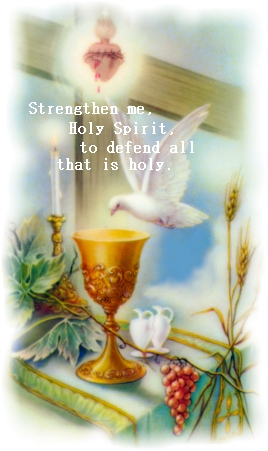 The
dove was seen by the father of St. Catherine of Siena above her head
while she was in prayer. The most important use of the dove in art,
however, is as the symbol of the Holy Ghost, which first appears
as such at the Baptism of Christ [John1:32]. The dove, symbol of the
Third Person the Holy Trinity, is shown in images of the Trinity,
Baptism, the Annunciation and with the Host and or Chalice at Holy
Mass. The
dove was seen by the father of St. Catherine of Siena above her head
while she was in prayer. The most important use of the dove in art,
however, is as the symbol of the Holy Ghost, which first appears
as such at the Baptism of Christ [John1:32]. The dove, symbol of the
Third Person the Holy Trinity, is shown in images of the Trinity,
Baptism, the Annunciation and with the Host and or Chalice at Holy
Mass. Seven doves are used to represent the seven spirits of God or the Holy Spirit in its sevenfold gifts of Grace. This refers to the prophecy of Isaiah 11:1, 2: "And there shall come forth a rod out of the stem of Jesse, and a branch shall grow out of His roots: and the spirit of the Lord shall rest upon Him, the spirit of wisdom and understanding, the spirit of counsel and might, the spirit of knowledge and of the fear of the Lord." The dove is also connected with the lives of several Saints other than St. Catherine. For instance, it is the attribute of St. Benedict because he saw the soul of his dead sister Scholastica fly up to Heaven in the shape of a white dove. The dove is also used as an attribute of St. Gregory the Great, for the dove of the Holy Spirit perched upon St. Gregory's shoulder while he wrote. DRAGON: Satan. Dragon chained or underfoot: The conquest of evil. The dragon as the enemy of God is vividly portrayed in Revelation 12:7-9: "And there was war in Heaven: Michael and his Angels fought against the dragon; and the dragon fought and his Angels, and prevailed not; neither was their place found anymore in Heaven. And the great dragon was cast out, that old serpent, called the Devil, and Satan, which deceiveth the whole world: he was cast out into the earth, and his Angels were cast out with him." The dragon, expelled from Heaven, continues his war against God. Thus, he is depicted as the devouring monster who angrily destroys his victims. The dragon is the attribute of St. Margaret, and of St. Martha, both of whom are said to have fought, and vanquished, a dragon. It is also the attribute of a number of other Saints, including St. George of Cappadocia, who slew the dragon 'through the power of Jesus Christ.' The dragon appears with the Apostle Philip, St. Sylvester, and the Archangel Michael, who is often shown with a dragon under foot, in token of his victory over the powers of of darkness. The serpent, symbolizing the Devil and Satan, is depicted as the tempter of Adam and Eve. 'And the Lord God said unto the woman, What is this that thou hast done? And the woman said, The serpent beguiled me, and I did eat' [Genesis 3:13]. Thus, the serpent represents in general the wily tempter that betrays man into sin. The serpent is sometimes portrayed at the foot of the Cross to signify that the evil power responsible for man's fall has been overcome by the power of Christ, Who died that man might be redeemed. EAGLE: The eagle may generally be interpreted as a symbol of the Resurrection. This is based upon the early belief that the eagle, unlike other birds, periodically renewed its plumage and its youthful vigor by flying near the sun and then plunging into the water. This interpretation is further borne out by Psalm 103:5: '. . . thy youth is renewed like the eagle's.' The eagle is also used to represent the new life begun at the baptismal font and the Christian soul strengthened by grace. 'But they that wait upon the Lord shall renew their strength; they shall mount up with wings as eagles . . .' [Isaiah 40:31]. The eagle is said to have the ability to soar until it is lost to sight, and still retain its ability to gaze into the blazing midday sun. For this reason, it has come to symbolize Christ. In a more general sense, it symbolizes those who are just; or stands for the virtues of courage, faith, and contemplation. More rarely, when it is depicted as a bird of prey, the eagle suggests the demon who ravishes souls, or the sins of pride and worldly power. The eagle also symbolizes generosity. It was believed that the eagle, no matter how great its hunger, always left half its prey to the birds that followed. The eagle is the particular attribute of St. John the Evangelist. The vision of Ezekiel 1:5, 10: ". . . out of the midst thereof came the likeness of four living creatures. ..as for the likeness of their faces, they four had the face of a man, and the face of a lion . . . the face of an ox . . . the face of an eagle," is interpreted as referring to the four evangelists. Because St. John, in his Gospel, soared upward in his contemplation of the Divine nature of the Saviour, the eagle became his symbol. In a more general sense, the eagle came to represent the inspiration of the Gospels. It is from this symbolic interpretation that the lectern, from which the Gospels are read, is often given the form of a winged eagle. EGG: Hope. Resurrection. The meaning is taken from the manner in which the young chick breaks forth from the egg at its birth. ERMINE: Purity: the is small animal has a whitish fur and is said to prefer death to being defiled. FALCON [wild]: Evil thought or action. FALCON [tame or domestic]: Holy man or Gentile converted to Catholicism. Courtliness: a symbol of the page accompanying the Magi FISH: Baptism. Believers. The symbol of Christ Himself, the most frequent symbolic use because  the
five Greek letters forming the word 'fish' are the initial letters of
the five words: 'Jesus Christ God's Soul Saviour'. In this sense, the
fish symbol was frequently used in Early Christian art and literature.
The fish is also used as a symbol of Baptism, for, just as the fish
cannot live except in water, the Christian cannot live save through the
waters of Baptism. the
five Greek letters forming the word 'fish' are the initial letters of
the five words: 'Jesus Christ God's Soul Saviour'. In this sense, the
fish symbol was frequently used in Early Christian art and literature.
The fish is also used as a symbol of Baptism, for, just as the fish
cannot live except in water, the Christian cannot live save through the
waters of Baptism. In Renaissance imagery, the fish is given as an attribute to Tobias because the gall of a fish restored the sight of his father Tobit; it is also given as an attribute to St. Peter, an allusion to his being a fisherman; and to St. Anthony of Padua, who preached to the fish. FLY: The fly has long been considered a bearer of evil or pestilence. In Catholic symbolism the fly is a symbol of sin. It sometimes appears in pictures of the Virgin and Child to convey the idea of sin and redemption. The fly as a bringer of disease was sometimes shown with the goldfinch, a 'saviour-bird' against the disease. FOX: Cunning. Fraud. Lust. Cruelty. Traditionally the symbol of cunning and guile, the fox symbolized the Devil. Though it was shown frequently in sculpture during the Middle Ages, it was for the most part confined to book illustration during the Renaissance. FROG: This has two opposite meanings: 1. Because of its reappearance after winter's hibernation, the Resurrection. 2. Because of its continual croaking and the fact that one of the plagues of Eygpt was a rain fo frogs [Chapter 8], it is sometimes the symbol of heretics or the repulsiveness of sin itself. More loosely, it is interpreted as a symbol of those who snatch at life's fleeting pleasures; hence it represents worldly things in general. GIRAFFE: In the Renaissance the giraffe was depicted more because of its strange appearance and its rarity among animals in Europe than for any symbolic meaning. GOAT: Fraud. Lust. Cruelty. The damned at the Last Judgement. This interpretation is based upon a long passage in the Bible (Matthew 25:31-46) which relates how Christ upon His coming, shall separate the believing from the unbelieving, as the shepherd separates the sheep from the goats. In the Renaissance the goat was usually shown in order to distinguish the sinners from the righteous.  GOLDFINCH:
The goldfinch is fond of eating thistles and thorns, and since all
thorny plants have been accepted as an allusion to Christ's crown of
thorna, the goldfinch has become an accepted symbol of the Passion of
Christ. In this sense, it frequently appears with the Christ Child,
showing the close connection between the Incarnation and the Passion. GOLDFINCH:
The goldfinch is fond of eating thistles and thorns, and since all
thorny plants have been accepted as an allusion to Christ's crown of
thorna, the goldfinch has become an accepted symbol of the Passion of
Christ. In this sense, it frequently appears with the Christ Child,
showing the close connection between the Incarnation and the Passion. GOOSE: Since the time of the Romans, the goose has been a symbol of providence and vigilance. The legend of the Capitoline geese that saved Rome from the invasion of the Gauls is well known. In Catholic art the goose is sometimes given as an attribute to St. Martin of Tours, because a goose is supposed to have revealed his hiding place to the inhabitants of Tours, who had come to call the Saint to be their bishop. GRASSHOPPER (Locust): The grasshopper, or locust, was one of the plagues visited upon the Egyptians because the Pharaoh's heart was hardened against the Word of the Lord. Accordingly, the grasshopper when held by the Christ Child is a symbol of the conversion of nations to Catholicism. This meaning is also derived from Proverbs 30:27: "The locusts have no king, yet go they forth all of them by bands," a passage early interpreted as referring to the nations formerly without Christ for their King. St. John the Baptist was said to have fed on locusts. GRIFFIN: This mythic creature, usually depicted with the head and wings of an eagle and the body of a lion, is used with two different and opposite meanings; on the one hand to represent the Saviour; on the other, because it is a combination of the preying of the eagle and the fierceness of the lion, to symboliz those who oppress and persecute Christians. HARE/RABBIT: Lust. Hare/Rabbit at the feet: Victory over lust. The hare, itself defenseless, is a symbol of men who put the hope of their salvation in the Christ and His Passion. A white hare is sometimes placed at the feet of the Virgin Mary to indicate her triumph over lust. HOG: The hog is used to represent the demon of sensuality and gluttony. It is frequently shown as one of the attributes of St. Anthony Abbot, who is reputed to have vanquished this demon. HORSE: In ancient times the horse was the emblem of the sun, as the ox was that of the moon. In the Renaissance, however, the horse was most often depicted as a symbol of lust. This interpretation is based on Jeremiah 5:8: "They were as fed horses in the morning: every one neighed after his neighbor's wife." HYENA: The unstable. Those who feed on false doctrine. LAMB: Innocence. Gentleness. Patience. Humility. Symbol of Christ in His sacrificial role. Many scriptural passages give authority for this symbolism. One reference is John 1:29: "The next day John seeth Jesus coming unto him, and saith, Behold the Lamb of God, which taketh away the sin of the world!" The Holy Lamb is often depicted with a nimbus, standing upon a small hill from which four streams of water flow [Revelation 14:1]. The hill represents the Church of Christ, the mountain of God's house. The streams represent the four Holy Gospels, the four rivers of Paradise, ever flowing and refreshing the pastures of the Church on earth. In pictures where Christ is shown as the rescuing shepherd, the lamb is also used to symbolize the sinner. This subject, usually called the Good Shepherd, is very frequent in Early Christian art, but was seldom used in the Renaissance. During the Renaissance the lamb was often depicted in representations of the Holy Family with the Infant St. John. Here, the lamb alludes to St. John's mission as the forerunner of Christ, and his recognition of Christ as the Lamb of God at the time of His Baptism. This meaning is indicated by the portrayal of St. John the Baptist pointing to a lamb which he usually holds in his left hand. A variation on this theme can be viewed HERE. The lamb (Latin, agnus) is given as an attribute to St. Agnes, who was Martyred because she declared herself to be the bride of Christ and refused to marry. It is also found as an attribute of St. Clement, who was guided by a lamb to the spot where he found water. LARK: The lark, because it flies high and sings only when in flight toward Heaven, has been taken as the symbol of the humility of the priesthood. LEOPARD: The leopard is a symbol of sin, cruelty, the Devil, and the Antichrist. It sometimes appears in representations of the Adoration of the Magi to show that the Incarnation of Christ was necessary for redemption from sin. LION: Strength. Our Lord. Courage. Fortitude. Kingliness. The lion is used in Renaissance art with various meanings, depending upon the circumstances. In general, when it is used it is emblematic of strength, majesty, courage, and fortitude. Because it once was believed that young lions are born dead, but come to life three days after birth when breathed upon by their sire, the lion has become associated with the Resurrection, and this is why it is symbol of Christ, the Lord of Life. The lion is one of the four animals that appear in the prophecy of Ezekiel. He is the symbol of the Evangelist Mark because St. Mark in his Gospel dwells most fully upon the Resurrection of Christ and proclaims with great emphasis the royal dignity of Christ. The winged lion is invariably the attribute of St. Mark, and appears also as the emblem of Venice, because this city was under the protection of St. Mark. St. Jerome is also closely identified with the lion. According to tradition the Saint removed a painful thorn from the paw of a lion, who thereupon became his close and faithful friend. It was a medieval belief that the lion slept with its eyes open. For this reason, he also became a symbol of watchfulness. In rarer instances the lion, because of its pride and fierceness, was used as symbol of the Prince of Darkness, this interpretation being suported by Psalm 90:13: "Thou shalt tread upon the lion an adder . . ." This passage is interpreted as Christ triumphing over the Devil. In addition, lions appear as attributes of St. Mary of Egypt, St. Euphemia, St. Onuphrius, and St. Paul the Hermit. OWL: The owl, since it hides in darkness and fears the light, has come to symbolize Satan, the Prince of Darkness. As Satan deceives humanity, so the owl is said to trick other birds, causing them to fall into the snares set by hunters. The owl also symbolizes solitude and, in this sense, appears in scenes of hermits at prayer. Its most ancient-thought attribute, however, is that of wisdom, and with this meaning, it is sometimes shown with St. Jerome. In another sense, the owl is an attribute of Christ, Who sacrificed Himself to save mankind, "To give light to them that sit in darkness and in the shadow of death . . ." [Luke 1:79]. This explains the occasional presence of the owl in scenes of the Crucifixion. 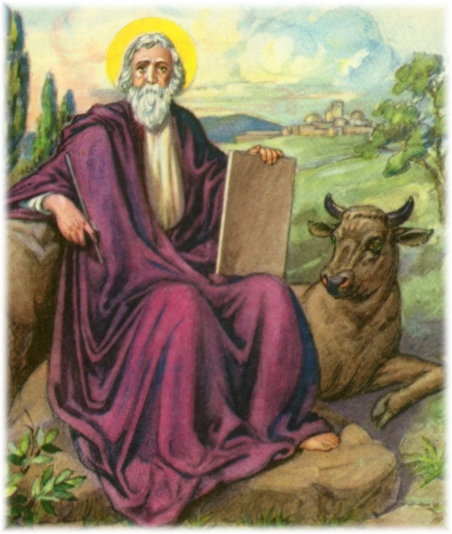 OX: Patience. Strength. Service. Endurance. Sacrifice. The ox, a sacrificial animal of the Jews, was often used in Renaissance painting to represent the Jewish nation. It is also a symbol of patience and strength as indicated aboveand almost invariably, the ox and the ass appear together in paintings of the Nativity. In the writings of some of the early Christian fathers, the ox is accepted as a symbol of Christ, the true sacrifice. This symbol is similarly used to represent all who patiently bear their yoke while laboring in silence for the good of others. The winged ox is the attribute of St. Luke because of his emphasis upon the sacrificial aspects of our Lord's atonement as well as upon the Divine priesthood. PARTRIDGE: In a good sense, the partridge is used as a symbol of the Church and of truth; but it is ordinarily symbolic of deceit and theft, and in a more general sense, of the Devil: "As the partridge sitteth on eggs, and hatcheth them not; so he that getteth riches, and not by right, shall leave them in the midst, his days, and at his end shall be a fool." [Jeremiah 17:11] PEACOCK: In Catholic art the peacock is used as the symbol of immortality. This symbolism is derived from an ancient belief that the flesh of the peacock does not decay. It is with this meaning that it appears in scenes of the Nativity. The 'hundred eyes' in the peacock's tail are sometimes used to symbolize the 'all seeing' Church. The peacock's habit of strutting and displaying the beauty of its feathers has caused it also to become a symbol of worldly pride and vanity. A peacock's feather is sometimes an attribute of St. Barbara, in reference to Heliopolis, the city of her birth. PELICAN: According to ancient belief, the pelican, which has the greatest love of all creatures for its offspring, pierces its breast to feed them with its own blood: It is on this basis that the pelican came to symbolize Christ's sacrifice on the Cross, because of His love for all mankind. In this sense, it also symbolizes the Eucharistic Sacrament. This interpretation is supported by Psalm 101:7: "I am like a pelican of the wilderness," which is an accepted allusion to Christ. The pelican is sometimes shown nesting on the top of the Cross. PHOENIX: The phoenix was a mythic bird of great beauty which lived in the Arabian wilderness. Its life span was said to be between three hundred and five hundred years. Periodically, it burned itself upon a funeral pyre; whereupon, it would rise from its own ashes, restored to all the freshness of youth, and would tenter upon another cycle of life. The phoenix was introduced into Christian symbolism as early as the first century, when the legend of this bird was related by St. Clement in his first Epistle to the Corinthians. In early Catholic art, the phoenix constantly appears on funeral stones, its particular meaning being the resurrection of the dead and the triumph of eternal life over death. The phoenix later became a symbol of the Resurrection of Christ, and commonly appears in connection with the Crucifixion. In another sense, the phoenix stands for faith and constancy. Though popular in the art of the Middle Ages, the phoenix is rare in Italian Renaissance paintings. RAM: Symbol of Christ. Leader of the herd. Because the ram is the leader of the herd, it is used as a symbol for Christ. Also, in the same way that the ram fights with the wolf and vanquishes him, so Christ battles with Satan and is victorious. The ram, the animal God caused to be placed in a thorny bush so that Abraham might sacrifice it in place of his son Isaac, represents Christ crowned with thorns and sacrifIced for mankind. In a general sense, the ram is used as symbol for strength. RAT/MOUSE: The rat, or the mouse, because of its destructiveness, is symbolic of evil. It is rarely seen in Renaissance art except as an attribute of St. Fina. The mouse is also a symbol for St. Gertrude of Nivelles, the patron of those who fear mice. RAVEN: According to a Jewish legend, the raven was originally white, but its feathers turned black when it failed to return to the ark, from which Noah had sent it to find out if the flood abated. Because of the blackness of its plumage, its supposed habit of devouring the eyes and the brain of the dead, and its liking spoiled flesh, the raven was selected as a symbol of the Devil, who throws the soul into darkness, invades the intelligence, and is gratified by corruption. The raven appears in a more favorable light in relation to certain Saints. It is the attribute of St. Vincent because God sent a raven to guard his sacred remains. The raven is also the attribute of St. Anthony Abbot and St. Paul the Hermit because it brought them a loaf of bread each day while they lived together in the desert. The raven, as symbolic of solitude, is associated with these hermit Saints. SCORPION: The scorpion is one of the symbols of evil. The sting of the tail of the scorpion is poisonous and causes great agony the person who is stung. It is often mentioned in the Bible, ". . . their torment was the torment of a scorpion, when it striketh a man" [Apocalypse 9:5]. Because of the treachery of its bite, the scorpion became a symbol of Judas. As a symbol of treachery, the scorpion appears on the flags and shields held by the soldiers who assisted at the Crucifixion of Christ. SNAIL: The snail was believed to be born from the mud, and to feed upon it. It was, therefore, interpreted as the symbol of the sinner, and of laziness, because it made no effort to seek food, but ate what it found at hand. SNAKE: Satan. Evil. This is because the Devil came in the form of a "serpent" or snake to Eve in the Garden of Paradise. SPARROW: Considered to be the lowliest among all birds, the sparrow came to be used as a symbol of the lowly, the least among all people, who were, nevertheless, under the protection of God the Father; for even the sparrow came to earth only through the will of God, and received from Him its means of life. It is also a symbol of the Holy Family, who lived a humble, lowly life in obedience to the will of God. SPIDER: The spider is used symbolically, first to represent the miser, for it bleeds the fly as the miser bleeds the poor; second, to represent the Devil, for the Devil prepares his traps as the spider, does its web; and third, to represent the malice of evil-doers whose webs will perish like those of the spider. The cobweb is a symbol of human frailty. STAG/HART/DEER/HIND: Piety.Faithful Christian longing for God. Christ the Savior. The stag takes its symbolic significance from Psalm 41:1: "As the hart panteth after the water brooks, so panteth my soul after thee, O God." Thus, the stag has come to typify piety and religious aspiration. Similarly, because the stag seeks freedom and refuge in the high mountains, it has been used to symbolize the solitude and purity of life. The stag, as the attribute of St. Eustace and St. Hubert, is shown with a crucifix between its horns. The stag without the crucifix is an attribute of St. Julian the Hospitator. The stag or hind is also the symbol of St. Giles, one of the Fourteen Holy Helpers because every day for a considerable period of time, when the Saint was living in the forest, a hind came to him to be milked as would a cow, thus supplying the hermit Abbot with milk. STORK: The stork is a symbol of prudence and vigilance, piety, and chastity. It was associated with the Annunciation because, as the stork announces the coming of spring, the Annunciation to Mary indicated the Advent of Christ. It is possible that the present north European and American fable whch is sometimes told to children that newborn babies are carried to their mothers by storks, may be derived from the association of this bird with the Annunciation. SWALLOW: In the Renaissance the swallow was a symbol of the Incarnation of Christ. For this reason, it appears in scenes of the Annunciation and of the Nativity, nestling under the eaves or in holes in the wall. It was thought that the swallow hibernated in the mud during the winter, and its advent in the spring was looked upon as a rebirth from the death-like state of winter. For this reason it also became a symbol of resurrection. UNICORN. The unicorn, according to myth, was a small animal, similar in size to a kid, but surprisingly fierce and swift with a very sharp, single horn in the center of its forehead like the rhinoceros. Suposedly no hunter could capture the animal by force, but it could be taken by means of tricking with bait, that of a pure virgin. The unicorn, sensing the purity of the maiden would run to her, lay its head in her lap, and fall asleep. Thus it was captured. For obvious reasons the mythic unicorn was early accepted as the symbol of purity in general and of feminin chastity in particular, an allegory of the Annunciation and the Incarnation of Christ, born of a Virgin. Thus, the unicorn is usually an attribute of the Virgin Mary, bul also of St. Justina of Padua and of St. Justina of Antioch, who retained their purity under great temptation. The unicorn is mentioned many times in Scripture, in truth the rhinoceros, for this term was not yet coined. One instance is Psalm 91:11: "But my horn shall be exalted like the unicorn .. ." WHALE: According to ancient legend, the huge body of the whale was often mistaken by mariners for an island, and ships anchored to its side were dragged down to destruction by a sudden plunge of the great creature. In this way, the whale came to be used as a symbol of the Devil and of his cunning, and the whale's open mouth was often depicted to represent the open gates of Hell. The whale also appears in the Biblical account of Jonah, who was swallowed by a whale and disgorged three days later. Allegorically, the experience of Jonah is likened to Christ in the sepulchre and His Resurrection after three days. Unfamiliarity with the appearance and habits of the whale, and even with the identification of the Biblical sea-monster as such, prevented the artists of the Italian Renaissance from painting naturalistic whales. Rather, Jonah's monster was, to them, either something in the way of a dragon, a great shaggy fish, or a dolphin. WOLF: Heresy. Gluttony. False prophets. The Devil. Yet, in sharp contrast, the wolf is sometimes used as an attribute of St. Francis of Assisi. This is based on the famous story of the wolf of Gubbio. A wolf that had been doing great damage was being hunted by the people of Gubbio, when St. Francis encountered it. He addressed it as 'Brother Wolf,' and protected it as a fellow creature who knew no better, and set about to reform it. WOODPECKER: The woodpecker is usually symbolic of the Devil, or of heresy, which undermines human nature and leads man to danmation. 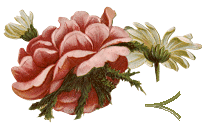 Contact Us Contact Us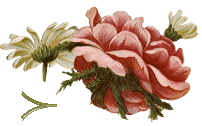 HOME-------SAINTS---------PATRONS www.catholictradition.org/Saints/signs1.htm |